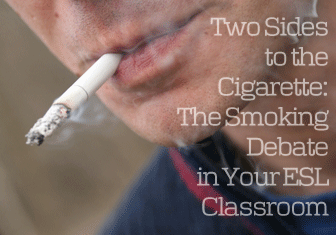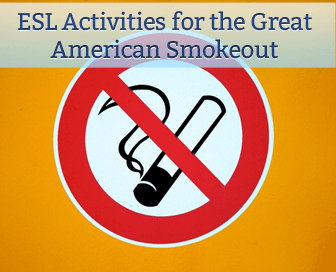Two Sides to the Cigarette: The Smoking Debate in Your ESL Classroom


On this day each year, smokers are encouraged to quit the habit or at least make a plan to quit. The goal is to grow a healthier nation, free of smoking related disease. Whether your students smoke or not, these activities will get them thinking about smoking and evaluating whether the pay offs are worth the risk.
Money In the Bank
The average smoker spends about seven hundred dollars a year on cigarettes. Practice using conditional structures by asking your students what they would do with an extra $700. Have your students create a wish list during a time of brainstorming, and challenge them to be as creative as possible. Then break your class into pairs or small groups. Review the conditional structure with your students by giving them an example, “If I had $700 I would buy lunch for all of my students.” Make sure your students know they should use the past tense for the if clause and would plus the simple form of the verb for the main clause. Then invite your students to share with one another what they would do with the extra money. If you like, have your students choose one of their options and imagine it detail. Then have them write a descriptive paragraph starting with the conditional sentence they practiced. The paragraph should then go on to give strong details about the scenario. If you like, have your students illustrate their paragraphs and display them on a bulletin board with the title “A Pack of Possibilities.”
Black and White and Read All Over
Though not as common as they were several years ago, readers still see advertisements for cigarettes. In these ads, the habit is portrayed as cool, sexy, sophisticated or tough. Ask your students to collect some cigarette advertisements to bring in to class. Post the ads around the room with a piece of paper under each one, and give your students some time to look at the ads and comment on them by writing their comments on the piece of paper. Students should try to recognize what strategies the advertisers are using to promote smoking and to which emotions they are trying to appeal. After looking at ads, show your students some cigarette packages bought in Canada. There, companies print graphic pictures of detrimental health conditions due to smoking. Again, post these pictures and ask your students to respond. Once everyone has had enough time to look at all the ads and cigarette packages, ask which one they feel is most effective. Do the ads make them want to smoke? Does the packaging discourage them from smoking? Have each student choose to design either a smoking advertisement or a nonsmoking advertisement. Each person can use some of the techniques he or she saw in the professional ads or use his own. When all the ads are finished, post them around the room and ask your class to vote on which one they think is most effective. Award a prize to the winner.
Ask the Public
Do your students have an accurate understanding when it comes to the public’s opinion about smoking? If your students are old enough to do some field research, you can give them time on the street conducting surveys to anyone who has a few minutes to spare. First as a class, brainstorm some questions you would like to ask the general public about smoking. They may include questions like, “Do you think people should be allowed to smoke in public? Should smoking be illegal in public places? Should people who smoke have to pay more for health care?” Once you have a large list, direct a class discussion to narrow down the pool of questions to the five most important, and ask each student to predict how the public will answer each of the questions. Then type up the survey and make five copies for each student in the class. Each student should then take those five surveys and find volunteers in the public who are willing to take them. They may choose to go to a coffee shop, grocery store (with permission) or public park. Your students should use this as a chance to practice their conversation skills. Once your students have finished their interviews, have them bring the results back to the class where you can compile all the data together. What is the majority opinion on each of the questions? Were your students’ predictions correct? Ask your class if any of the answers surprised them, and ask if any answers were just as they expected.
It’s the Law
Allegheny County, Pennsylvania recently passed a law which makes smoking in restaurants throughout the county illegal. This action is being taken by many areas of the country and being considered by many more. Do your students agree or disagree with this change in societal acceptance? Hold an informal debate either as a class or in groups of about five students each on whether smoking should be banned from public places. Whether your students support or refute the proposition, make sure everyone gives reasons for his answer. After the discussion, ask your students what the best arguments on each side of the issue are and whether anyone changed his mind after the group discussion.
Follow up this activity by asking your students to write a formal letter to the local government official either supporting the current law on smoking in public or recommending that the current law be changed. Students will first have to determine what the local smoking laws are. After writing the letters, have your students mail them and share any response with the class.
Either way, this November, encourage your students to give the habit a second thought, and maybe they will become healthier people because of it!